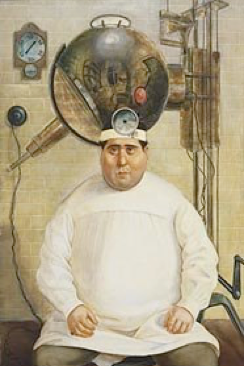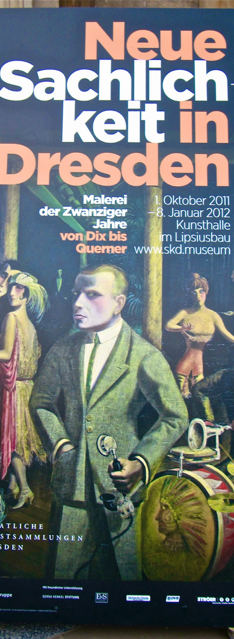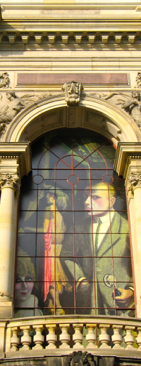Kunsthalle in lipsiusbau
Dresden
saxony, eastern Germany
europe
november 9-14 & 19-22, 2011


Kunsthalle in lipsiusbau
Dresden
saxony, eastern Germany
europe
november 9-14 & 19-22, 2011


The Neue Sählichkeit exhibition in Dresden was held in the former Kunstakademie where the Sächsischer Kunstverein or Saxon Art Society met and exhibited. A formidable building in the center of the Historic District, Lipiusbau , named after its architect, Constantin Lipsius, is situated between the Frauenkirche and the Brühlsche Terrasse. This impressive building, with its distinctive glass dome, is a prominent feature in Dresden’s skyline. After its partial destruction in 1945, the building was left in a state of disuse for many years. Reconstruction began in 2005, leaving the imprint of its destruction to contrast with the grand classical architecture, past and present juxtaposed. Now, this grand building, now known as the Kunsthalle, has once again become an impressive venue for art exhibitions, mirroring its early history of exhibitions by not only the Saxon Art Society, but also a group known as “Brücke” that exhibited here as early as 1905. Henry and I both considered ourselves fortunate to have been in Dresden during the Neue Sachlichkeit exhibition at the Kunsthalle in Lipsiusbau. This Post-WW-I art movement, translated to mean “New Objectivity”* was founded by two artists, George Grosz and Otto Dix. The artists who participated in this politically inspired movement painted in this cool, realistic, somewhat cynical style with a socially critical stance. Both Dix and Grosz, who had served in WW-I, were anti-war, as were many of their colleagues. These two, as well as Max Beckmann were considered to be in the subcategory known as “Verists”. These artists painted in a style that aggressively attacked the evils of society and those in power, demonstrating in harsh terms the devastating effects of WW-I and the economic climate upon individuals. The Verists abandoned any pictorial rules earlier developed by the Dadaists, emphasizing the ugly and sordid, thus creating a language of “satirical hyperrealism”. Christian Schad depicted reality that suggested both an empirical detachment and an intimate knowledge of the subject, characterized by “a precision so sharp that it seems to cut beneath the skin”, according to the art critic Wieland Schmied. His work often included psychological elements suggesting an underlying unconscious reality. In other works by the Verists, satirical scenes often depicted a madness behind the subjects, lending a cartoon-like atmosphere. In addition to those artists already mentioned, other Verists included Schlichter, Hans Grundig, Wilhelm Lachnit, Karl Hubbuch, George Scholz, Wilhelm Schnarrenberger. A second subcategory of this New Objectivity has been referred to as “Magic Realists” or “Classicists”. In this style, the artists chose to counteract the German Expressionist art with a more positive style, crystallizing everyday objects to be strange and fantastic, existing in a world of wonder. Artists in this category sought a return to order, a leaning that could be found throughout Europe in the Italian metaphysical painters or in the work of Henri Rousseau. The Neu Sachlichkeit artists painting in this style included Georg Schrimpf, Alexander Kanoldt, Carlo Mense, Heinrich Maria Davringhausen, and William Heise.
*Note: other translations of Neue Sachlichkite other than New Objectivity include: New Resignation, New Sobriety, New Dispassion as their is no direct translation to English.
PHOTOS: Left column: 1. The distinctive dome of Lipiusbau.2. The poster advertising the Neue Sachlichkeit exhibition at Lipsiusbau in Dresden. Top Right: The Eclipse of the Sun, a painting by George Grosz, 1926. Bottom Two: Left: Detail, façade of Lipiusbau with a transparency of a Max Beckmann painting advertising the Neue Sachlichkeit exhibition positioned to fill the window. Right: Dr. Mayer-Hermann, a painting by Otto Dix, 1926.

Neue Sachlichkeit




